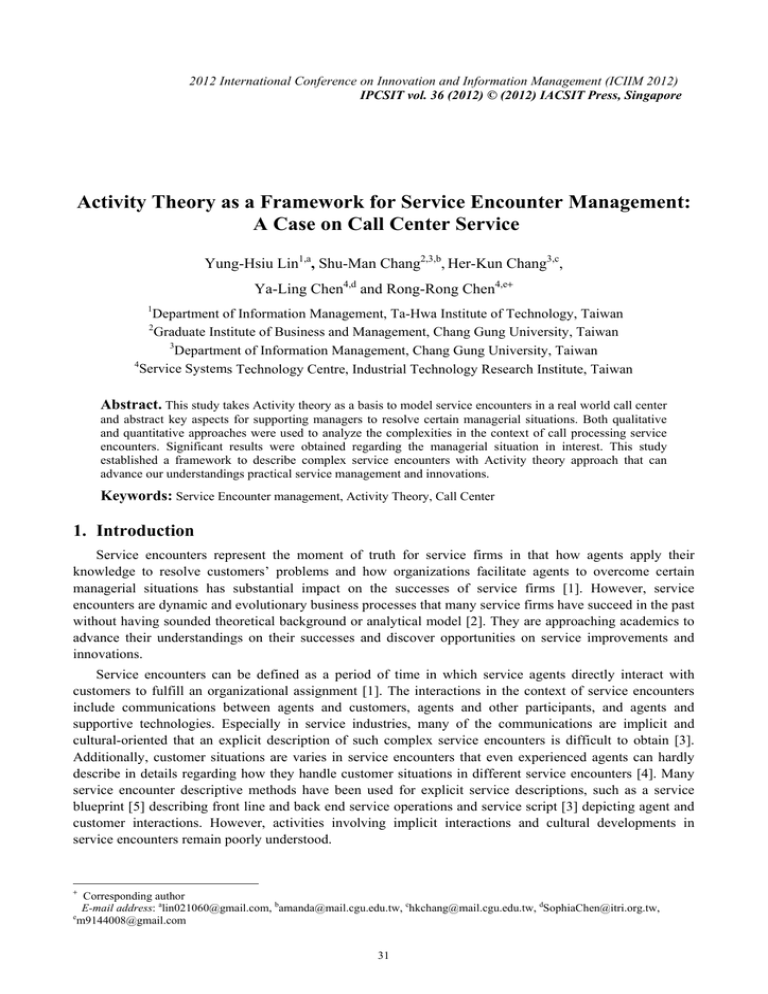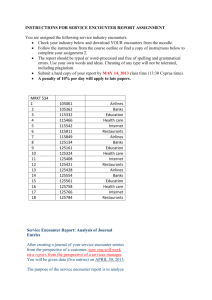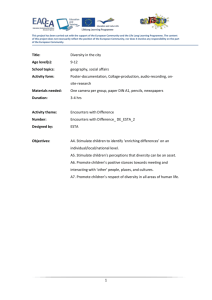Activity Theory as a Framework for Service Encounter Management: Yung-Hsiu Lin ,
advertisement

2012 International Conference on Innovation and Information Management (ICIIM 2012) IPCSIT vol. 36 (2012) © (2012) IACSIT Press, Singapore Activity Theory as a Framework for Service Encounter Management: A Case on Call Center Service Yung-Hsiu Lin1,a, Shu-Man Chang2,3,b, Her-Kun Chang3,c, Ya-Ling Chen4,d and Rong-Rong Chen4,e+ 1 Department of Information Management, Ta-Hwa Institute of Technology, Taiwan Graduate Institute of Business and Management, Chang Gung University, Taiwan 3 Department of Information Management, Chang Gung University, Taiwan 4 Service Systems Technology Centre, Industrial Technology Research Institute, Taiwan 2 Abstract. This study takes Activity theory as a basis to model service encounters in a real world call center and abstract key aspects for supporting managers to resolve certain managerial situations. Both qualitative and quantitative approaches were used to analyze the complexities in the context of call processing service encounters. Significant results were obtained regarding the managerial situation in interest. This study established a framework to describe complex service encounters with Activity theory approach that can advance our understandings practical service management and innovations. Keywords: Service Encounter management, Activity Theory, Call Center 1. Introduction Service encounters represent the moment of truth for service firms in that how agents apply their knowledge to resolve customers’ problems and how organizations facilitate agents to overcome certain managerial situations has substantial impact on the successes of service firms [1]. However, service encounters are dynamic and evolutionary business processes that many service firms have succeed in the past without having sounded theoretical background or analytical model [2]. They are approaching academics to advance their understandings on their successes and discover opportunities on service improvements and innovations. Service encounters can be defined as a period of time in which service agents directly interact with customers to fulfill an organizational assignment [1]. The interactions in the context of service encounters include communications between agents and customers, agents and other participants, and agents and supportive technologies. Especially in service industries, many of the communications are implicit and cultural-oriented that an explicit description of such complex service encounters is difficult to obtain [3]. Additionally, customer situations are varies in service encounters that even experienced agents can hardly describe in details regarding how they handle customer situations in different service encounters [4]. Many service encounter descriptive methods have been used for explicit service descriptions, such as a service blueprint [5] describing front line and back end service operations and service script [3] depicting agent and customer interactions. However, activities involving implicit interactions and cultural developments in service encounters remain poorly understood. + Corresponding author E-mail address: alin021060@gmail.com, bamanda@mail.cgu.edu.tw, chkchang@mail.cgu.edu.tw, dSophiaChen@itri.org.tw, e m9144008@gmail.com 31 Activity theory, founded by Russian psychologists Vygotsky and Leontiev, has been defined as a philosophical and cross-disciplinary framework for describing tool-mediated human activities both at individual and social levels [6-7]. It maintains that current state of how people conducting activities are the results from their cultural and historical developments. People and the mediated tools will both evolve and adapt to the contextual factors during the development. Two structures including a psychological hierarchy and an activity model were defined in Activity theory to describe the interactions and developments in a specific context [7]. Activity theory has been applied in many practical studies, such as human-computer interface analysis for developing software applications [8], workflow redesign and cooperation analyses for understanding complexity within workplace [4], and may have the potential to be used for understanding complex interaction in the context of service encounters. This study takes Activity theory as a basis to model service encounters in a real world call center and abstract key aspects for supporting managers to resolve certain managerial situations. Call processing is the service encounter in interest and a performance indicator has been identified as the managerial situation to be improved. This study adopted both qualitative and quantitative approaches to analyze interactions within service encounters both at individual agents and organizational context levels. This study aims to describe complex activities in practical service encounters in general and provide a framework for practitioners and researchers to build theoretical models through analyzing real world situations in specific. 2. Method 2.1. Research Background Beta.com is a professional call center providing services for manufacturers maintaining their suppliers’ relationships with software applications. The call center supports approximately 10,000 suppliers who use 30 sets of software applications. An average of 8,000 incoming calls per month requires timely processing by both 1st line and 2nd line agents. The 1st line agents are the major roles for resolving customer problems and the 2nd line agents are more managerial roles than operational ones. Since customer problems are varying in different service encounters, common problems have been categorized and designed in a computer and telephony integration (CTI) system. The system is the backbone of call center daily operations and records the details of how agents processing incoming calls. 2.2. Modeling Service Encounters with Activity Theory Processing incoming call is a business activity assigned to 1st line agents who need to have certain level of knowledge and skills to identify and resolve customer problems. In order to understand such complex activities in real world situations, researchers were organized to participate in agent training courses, review call center operational documents, and observe practical call processing service encounters. Additionally, indepth interviews were administrated focusing on the key attributes involved and the actions required in processing incoming calls. Open-ended questions were designed and asked both in formal meetings and informal occasions. The notes from interviews were edited and discussed with 2nd line agents and the managers to ensure the validity of our findings and verify researchers’ understandings. The structures from Activity theory were used to build contextual model and establish operational procedure of call processing service encounters. Fig. 1 depicts contextual model of service encounters in that 1st line agents supported with the CTI system take incoming calls toward the direction of call resolutions. The agents will follow certain organizational rules, participate in community activities to obtain operational skills and experiences, and ask for assistances from 2nd line agents. This model provides a holistic view of call processing service encounters that can offer a common ground to researchers and practitioners for further analyses. Fig. 2 illustrates a sequence of actions required to perform call processing activity in that explicit or conscious actions were identified and implicit or unconscious operations were collected regarding each action. This sequence can provide guidance for agents to conduct a service encounter and the operations representing different skills that should be shared among agents for improving organizational performance. 2.3. Discovering Opportunities of Performance Improvements 32 The structures of Activity theory depict a common picture of service encounters from contextual and procedural perspectives that managers can review this business activity from different parts of interactions and at different agent psychological levels. One managerial situation designated for improvement in this study is unclassified call ratio. Unclassified call ratio is a call center performance indicator that for every incoming call, 1st line agents must classify this call into certain problem categories through the interfaces of the CTI system. For those problems that 1st line agents cannot timely identify, will be classified into “others” category. The higher this ratio represents the lower of problem identification skills regarding customer problems identification. A managerial intervention was administrated for three months providing training courses regarding customer problem descriptions and motivating experiences sharing in relation to customer problem identification. All 1st line agents (N = 7) were included. Operational data before and after the intervention were extracted from the database of CTI system for further analysis. Fig. 1 Contextual Model of Call Processing Service Encounters Fig. 2 Operational Procedure of Call process Service Encounter 3. Results The results from data analysis revealed significant differences between the before and after the intervention regarding the unclassified call ratio. Fig. 3 indicates the differences of each agent in terms of three stages of the intervention. 33 Fig. 3 Differences of Unclassified Call The results from the qualitative interviews have been used to construct abstractions of call processing service encounters as indicated in Fig. 1 and 2. One excerpt from the interviews representing how agents share their practical experiences was discussed by one 1st line agent as: Many operational skills cannot be obtained from formal training courses and most of customer problems were not mentioned clearly in the courses or even they did I could not understand before practical encountered. Lunch hour is a good gathering function that creates a sense of community and enables us to share operational experiences and learn from each others. Although there are some question and answer sets designed in the CTI system, many customer problems need immediately answers that searching information from the system during a rush service encounter seems infeasible. 4. Summary The managerial intervention obtained statistically significance for the unclassified call ratio. This result may partially be contributed by improving problem identification time during service encounters and sharing problem information and skills in organizational context. The structures from Activity theory provides both contextual and procedural views of service encounters that experienced managers can discover opportunities of performance improvements [4]. Moreover, modern service encounters are supported with certain technologies that operational details can be recorded for further analyses. Qualitative interviews revealed insights regarding social and cultural contexts that may not be obtained from quantitative analyses. In this study, the knowledge and skills for conducting service encounters are difficult to be included in formal training courses and many of that are embedded in social and cultural contexts [9]. Creating and maintaining such contexts has becoming important aspect for the success of service firms. This study established a framework to describe such complex contexts with Activity theory approach that can advance our understandings on how real world service encounters should be modeled and how the framework can be used for practical service management and innovations. 5. Acknowledgement This work was partly supported by the Industrial Technology Research Institute and Chang Gung Memorial Hospital (under grants CGURP UARPD3A0151). The authors are grateful to the anonymous referees for their valuable comments, which help to improve the paper. 6. References [1] G. L. Bradley, J. R. McColl-Kennedy, B. A. Sparks, N. L. Jimmieson and D. Zapf: Service encounter needs theory: a dyadic, psychosocial approach to understanding service encounters. In W.J. Zerbe, C.E.J. Hartel and N.M. Ashkanasy (Eds.), Emotions and organizational dynamism (pp. 221-258). Bingley UK: Emerald Group Publishing Limited (2010). 34 [2] H. Chesbrough, J. Spohrer: A Research Manifesto for Services Science. Communications of the ACM Vol. 49 (2006) 35-40+33-34. [3] J. O’Sullivan, D. Edmond, and A. H. M. Ter Hofstede: Service Description: A Survey of the General Nature of Services. Queensland University of Technology, Technical Report FIT-TR-2003-02 (2003). [4] H. Worthen: Studying the Workplace: Considering the Usefulness of Activity Theory. Convergence Vol. 37 (2004), p. 7. [5] G. L. Shostack: Service Positioning through Structural Change. Journal of Marketing Vol. 51 (1987), p. 34-43. [6] A. N. Leontyev: Activity and consciousness. Philosophy in the USSR: Problems of Dialectical Materialism. Moscow: Progress Publishers (1977), p. 180-202. [7] Y. Engestrom, R. Miettinen, and R. L. Punamaki-Gitai: Perspectives on Activity Theory. Cambridge University Press (1999). [8] B. A. Nardi: Context and Consciousness: Activity Theory and Human-Computer Interaction. MIT Press (1996). [9] M. Hertzum: Collaborative Information Seeking: The Combined Activity of Information Seeking and Collaborative Grounding. Information Processing & Management, Vol. 44 (2008), p. 957-962. 35







